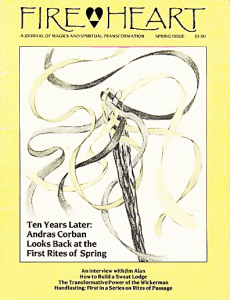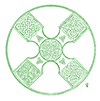 Rites of Passage
Rites of Passage
Handfasting
by Sue Curewitz Arthen ©1988
Five years ago, as a mother of two, I began to write a magazine column entitled “Pagan Childe”, focusing on issues around raising the next generation. Complications set in … I left my mate and children and became quite absorbed in a new discovery. To be able to write about the generation I am helping to raise, I needed to have a better sense of the shape of the generation I am from – and what shapes me, in part, are the life cycles I live through. As a pagan, I have faith that my experiences of the rites of life can often be different from other people’s. The degree of conscious celebration and ritual alters the experience and alters me. As members of a pagan community, we share and invite these complex alterations, and it is on these experiences that this series will focus.
The ritual of handfasting was chosen with deliberation as the first in this series. It is clearly a ritual that evokes images of Spring (or perhaps the energy of Spring invokes the ritual!), The most important reason is that there is something unique about the ritual of handfasting. Birth, puberty and death, as rites, happen to us: there is little scope for free will. Childbearing and parenting as rites of passage are only modestly under our control. We are far more likely to be able to prevent them than “plan” them. Some consider initiations, both magickal and those offered by life, as rites of passage. Here again, there seems little free will involved: life’s initiations happen to us as well, and although we may “choose” magickal initiations, many experience a sense of need when they reach that particular doorway that precludes any sense of choice, The pledging of a vow between two people is the one chance to voluntarily create and experience a rite of passage.
I was tempted, while writing, to digress into lengthy discussions of why we marry – the societal custom of marriage, its attendant purposes, benefits and disadvantages. Handfasting is often equated with marriage done simultaneously with a civil ceremony, or done in a separate but equal ceremony. So, why do we do it?
My research began in a time-honored traditional way. “Handfast” and its variations are defined in the Oxford English dictionary as “to make a contract of marriage between (parties) by joining of hands.” In several well known publications there are printed versions of some handfasting rituals. But because there is little in the way of scholarly material, I asked for help from the community. I called friends in the pagan network from all over New York and New England, and got names and numbers of their friends. I questioned strangers! Men, women, lesbians, gays, celebates; people of all ages were asked three questions:
- Have you or would you ever handfast?
- Was it/would it be simultaneous with, separate from a civil or other religious ceremony, or with no civil ceremony at all?
- Why did you/would you handfast?
The issues around civil services evoked a fairly predictable range of feelings from this group. A civil or other religious ceremony (i.e. legalized marriage) was very important for some, irrelevant to others, and a definite issue for the gays and lesbians for whom this is not yet a legal right in our society. I discovered that the feelings around handfasting that were shared with me form a definite symbolic image – the symbol for infinity.
On one side, or curve, people handfast because there is a primal need to share this rite with one’s family. Family, from a person’s family of birth to the family of one’s coven, was all encompassing. Most people combined a degree of pagan ritual with a degree of civil marriage, and found that by carefully choosing those degrees, they could share this intense moment with everyone they defined as family. To be able to share one’s pagan self, especially for a “closet” or “quiet” pagan, can be incredibly meaningful, and not terribly difficult, since so many pagan symbols have merged into everyday use. It is the consciousness that the couple involved brings to the circle that makes the difference.
On the other curve, this rite raises energy that can also be shared with the Universe. One image shared with me was that the joy and happiness of this rite creates “a beacon on the astral plane” for all to enjoy and share. Handfasting acknowledges that we are part of something much greater than the physical plane. We are in relationship to those other planes; we need to manifest “as above, so below.”
In the center, at the intersection, the crossroad of infinity, are two people binding themselves in a vow – with their earthly family on one side and their universal family on the other. We find ourselves here because this circle will give shape to vows, intentions and energies that are often intangible. We find ourselves here because it becomes a reference point for ourselves and those around us. We find ourselves here because we are stepping through a doorway. We need witnesses for who we are as individuals entering the doorway, and to the emerging shape of the energies we raise up as a couple. We will need the love and support of these friends as we travel this journey, whether for a year and day, or much longer.
While people shared their thoughts and feelings with me, I took notes, recorded the images we shared, and tried to pay careful attention. The thing I found most interesting was not the shape of this rite as it affects us as individuals, but how the rites we are engaging in are building our community. In everyday life, the customs we follow evolved to reflect the needs and energies of the people, just as ours are now evolving. But in everyday life, the customs are in place and in force to maintain the structure as we know it. What filled me with wonder was the sense that we, as a pagan community, are weaving rites and symbols from long ago, from between worlds, and from the here-and-now, to shape the society in which we want to live, mature, give birth and die … a society manifesting “power- within.”
SUE CUREWITZ ARTHEN is a mother, bookkeeper, Elder and Priestess, and now writer of articles. She does all these things with a lot of help from her friends.
